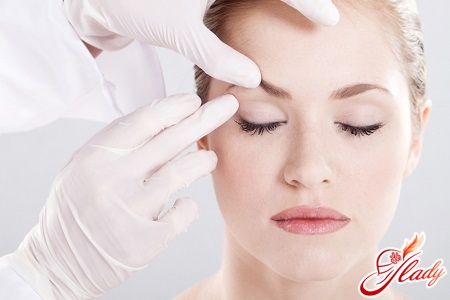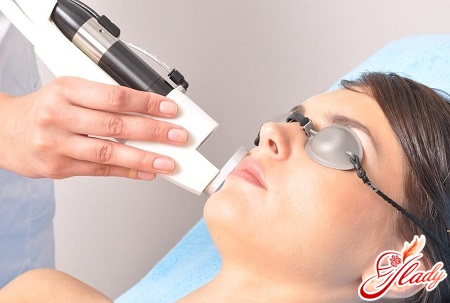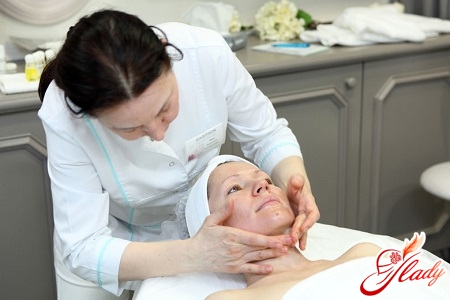
Skin cancer of the face is quite seriousoncological disease. It occurs on open surfaces of the face. Most often it affects the corners of the eyes, nose, temples, and ears. Each form has its own signs and symptoms. In any case, timely treatment is necessary, which is selected by an experienced specialist.
The main symptoms of the disease
Effective treatment may depend on the cause,which skin lesions developed. Of course, there is no definitive cause. But many factors increase the risk of developing cancer in the human body. First of all, this is excessive insolation, exposure to carcinogens, ionizing radiation, and others. The most common carcinogen is considered to be tobacco smoke, so cancer most often affects smokers who have had the bad habit for a long time. Also, the signs can worsen and manifest themselves against the background of weak immunity. The protective function of the body decreases after various diseases. Of course, the appearance of the skin lesion depends on the form of cancer. Most often, it looks like plaques, single nodes, superficial erosion. Not in all cases, a person notices the symptoms, so treatment begins at an advanced stage, which significantly reduces its effectiveness. The main signs of oncological skin lesions are bleeding, ulcers, and pain when touching the face. Also, a sign that the skin is affected by cancer can be thickening of existing moles, a change in their shape and size. As a rule, a common nevus has a regular and symmetrical shape, and its structure should not have any changes. Any changes in shape, color, or size are a reason to contact an oncologist, as this can often be a sign of melanoma in the body. The changed mole begins to itch, scratch, there is a burning sensation, the structure becomes looser, and may bleed. Carcinoma (the medical name for a malignant tumor of the epithelium) is one of the types of skin cancer. It is the formation of bumps or plaques with a shiny surface, inside which an ulcer can form. Untimely treatment leads to various complications that affect other body systems. Harmful metastases spread to the lymph nodes, and the disease begins to progress rapidly. Therefore, it is advisable to begin treatment at the first suspicion of the disease. As a rule, it is better to play it safe and visit an experienced dermatologist who will examine the patient and take the necessary tests to make a diagnosis. As a rule, examination of suspicious areas on the face is accompanied by histological examination of the material. Other additional examinations may be used to determine the presence or absence of metastases.
Effective cancer treatment
One of the most common waysremoval of oncological lesions is a surgical intervention. Surgical removal includes various methods: excision of the tumor in the classical way, with electric current (electrocoagulation), cold nitrogen (cryodestruction). In any case, radiation therapy is additionally prescribed, which consolidates the result obtained and does not allow harmful cells to form again in the body. It is much easier and more expedient to prevent the occurrence of the disease than to further expose the body to the effects of fairly strong drugs that simultaneously destroy useful cells along with harmful ones. Removal of skin lesions, which includes effective treatment, leaves scars. Therefore, additional cosmetic procedures are required in the future, which hide external defects on the face and restore a smooth skin surface. A modern and effective method of treating oncology is the use of a laser. Already after the first session, cancer cells begin to die. The number of procedures largely depends on the severity and form of the disease. As a rule, after using a laser, a relatively small scar remains on the skin, which gradually decreases in size. The use of medications is necessary to improve the final result, but is not an independent method of treatment. One group of drugs is prescribed before the operation, another - during the period of rehabilitation and recovery of the body. Of course, at the entire stage of recovery, you should adhere to a balanced diet and lead a healthy lifestyle. Properly selected foods enrich the body with nutrients, vitamins, essential microelements that have a beneficial effect on the regeneration of epithelial cells. This allows you to restore a smooth surface and normalize internal skin processes in a relatively short period of time. But even after successful treatment, it is advisable to regularly visit an oncologist to prevent the recurrence of malignant processes. This is especially true for those people who are predisposed to cancer (including skin cancer).
Prophylaxis of oncological diseases
To avoid having to treat skin cancer,it is advisable to follow preventive measures. First of all, you should avoid prolonged exposure to direct sunlight. If a person is under the sun, it is necessary to apply special protective agents to the skin surface that prevent ultraviolet radiation from penetrating inside. The rays are most dangerous for people with light skin. It is necessary to regularly care for the skin of the face. Care includes daily cleansing from various contaminants, the use of moisturizing and protective creams, and skin nutrition. It is also necessary to promptly treat various mechanical injuries (wounds, scratches), skin diseases, since all this gradually leads to the development of a malignant process in the body.









